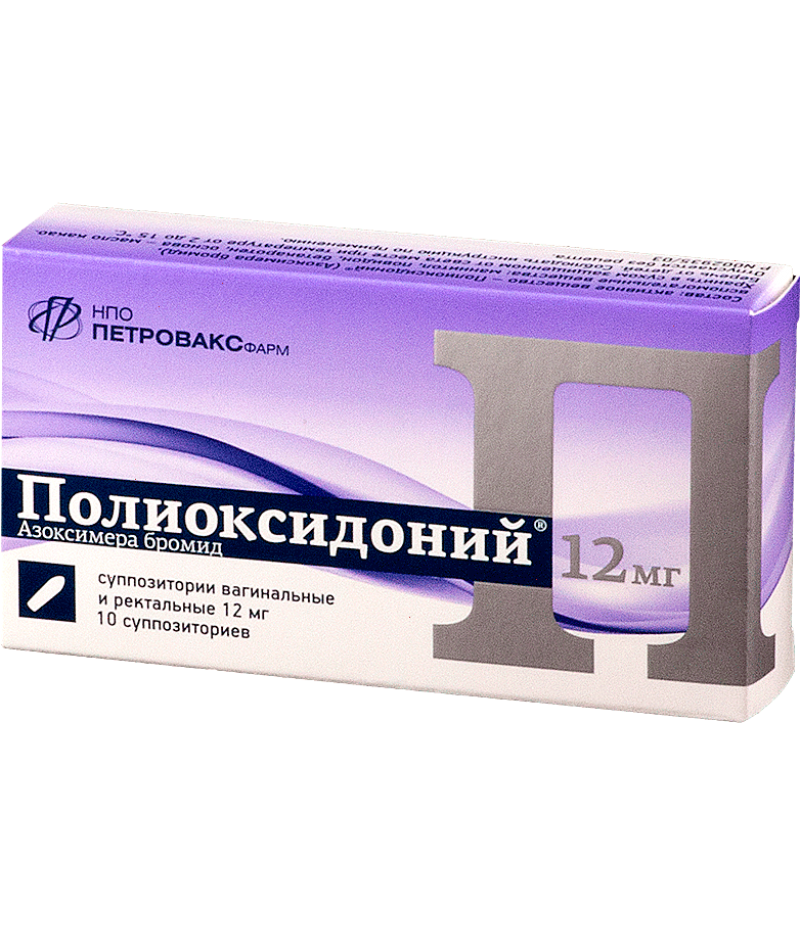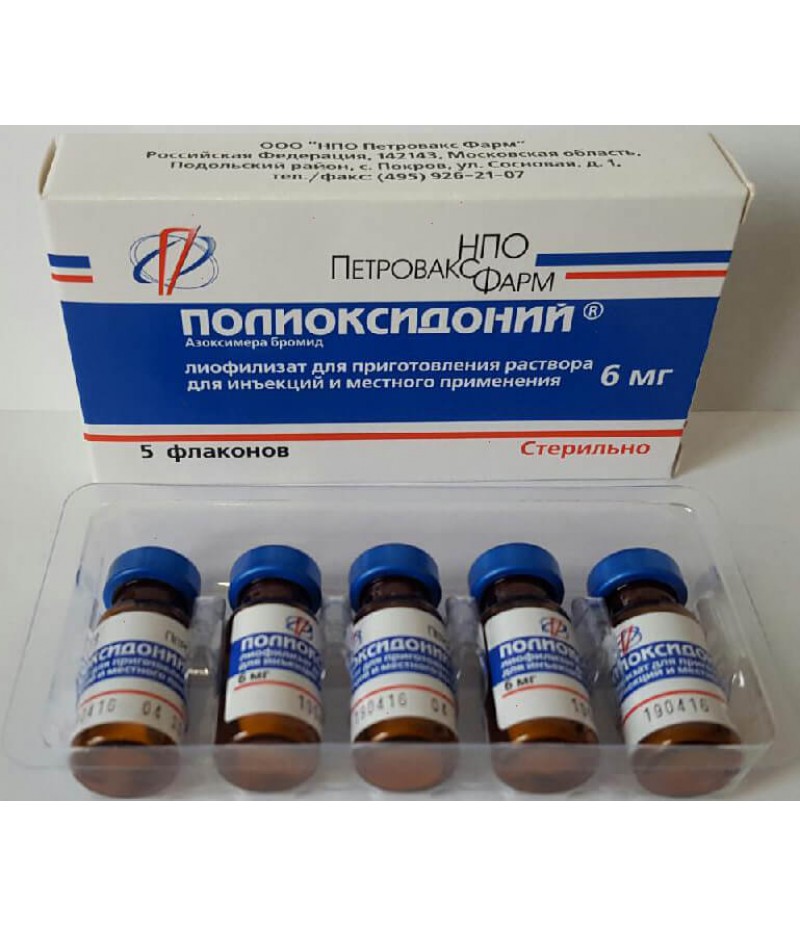Polyoxidonium supp 12mg #10
- $43.94
- 2 or more $42.80
- 3 or more $41.93
- Availability:In Stock
Polyoxidonium suppositories instructionYou can buy Polyoxidonium suppositories hereForm of release, composition and packagingSuppositories vaginal and rectal torpedo-shaped, light yellow color, with a
Tags: supp
Polyoxidonium suppositories instruction
You can buy Polyoxidonium suppositories here
Form of release, composition and packaging
Suppositories vaginal and rectal torpedo-shaped, light yellow color, with a weak specific odor of cocoa butter; suppositories must be homogeneous; On the cut, an air rod or a funnel-shaped depression is allowed.
1 supp.
azoxime bromide 12 mg
Excipients: mannitol - 3.6 mg, povidone K17 - 2.4 mg, cocoa butter - 1282 mg.
5 pieces. - packings cellular planimetric (2) - packs cardboard.
pharmachologic effect
Azoxymer bromide has a complex action: immunomodulating, detoxifying, antioxidant, anti-inflammatory.
Azoximer bromide increases the body's resistance to local and generalized infections. It restores immune responses in secondary immunodeficiency conditions caused by various infections, traumas, burns, malignant tumors, complications after surgical operations, the use of chemotherapeutic agents, incl. cytostatics, steroid hormones.
The basis of the mechanism of immunomodulatory action of azoxime bromide is a direct effect on phagocytic cells and natural killers, as well as stimulation of antibody formation. Azoximer bromide is capable of stimulating the synthesis of interferon alfa and interferon gamma, which determines its antiviral efficacy and the ability to prescribe for the prevention and treatment of influenza and ARVI.
The detoxification and antioxidant properties of azoxime bromide are determined by the structure and high molecular weight of the preparation and are not associated with the activation of immune mechanisms. Azoximer bromide blocks soluble toxic substances and microparticles, has the ability to excrete toxins from the body, salts of heavy metals, inhibits lipid peroxidation. The combination of antioxidant, antiradical, membrane-stabilizing and chelating properties makes azoxime bromide a powerful anti-inflammatory agent.
Inclusion of Polyoxidonium suppositories in the complex therapy of cancer patients reduces the intoxication on the background of chemo- and radiotherapy, in most cases allows the standard therapy without changing the scheme due to the development of infectious complications and side effects (myelosuppression, vomiting, diarrhea, cystitis, colitis and others).
The use of azoxime bromide against the background of secondary immunodeficiency states allows to increase the efficiency and shorten the duration of treatment, significantly reduce the use of antibiotics, bronchodilators, GCS, and prolong the period of remission.
Azoximer bromide is well tolerated, does not have mitogenic, polyclonal activity, antigenic properties, does not have allergic, mutagenic, embryotoxic, teratogenic and carcinogenic effects.
Pharmacokinetics
Suction and distribution
Azoximer bromide in the form of suppositories with rectal administration has a high bioavailability (at least 70%). Cmax in the blood plasma after administration is achieved after 1 hour. Half-distribution period is about 0.5 h. No cumulative effect.
Metabolism and excretion
In the body, Polyoxidonium suppositories is hydrolyzed to oligomers, which are excreted mainly by the kidneys. T1 / 2 - 36.2 h.
Indications
As part of complex therapy for the correction of immune deficiency in adults and children over 6 years of age
- with chronic recurrent infectious-inflammatory diseases, which can not be standardized, both in the acute stage and in the stage of remission;
- with acute viral, bacterial and fungal infections;
- with inflammatory diseases of the urogenital tract, incl. urethritis, cystitis, pyelonephritis, prostatitis, salpingoophoritis, endomyometritis, colpitis, cervicitis, cervicosis, bacterial vaginosis, incl. viral etiology;
- with different forms of tuberculosis;
- for allergic diseases complicated by recurrent bacterial, fungal and viral infections (including pollinosis, bronchial asthma, atopic dermatitis);
- In autoimmune diseases (including rheumatoid arthritis, chronic autoimmune thyroiditis), complicated by infectious syndrome against long-term use of immunosuppressants;
- with complicated ARI or acute respiratory distress syndrome;
- for activation of regenerative processes (including fractures, burns, trophic ulcers);
- for rehabilitation often and for a long time (4-5 times a year) of ill persons;
- during and after chemo-and radiation therapy of tumors;
- to reduce nephro- and hepatotoxic effects of drugs.
In the form of monotherapy:
- for the prevention of recurrent herpetic infection;
- for seasonal prevention of exacerbations of chronic foci of infections;
- for the prevention of influenza and acute respiratory infections in the pre-epidemic period;
- for correction of secondary immunodeficiencies, arising from aging or exposure to adverse factors.
Contraindications
- increased individual sensitivity;
Acute renal failure;
- Pregnancy;
- the period of breastfeeding;
- Children under 6 years.
With caution: chronic renal failure (appoint no more than 2 times a week).
Dosage
Polyoxidonium suppositories is intended for rectal and intravaginal administration of 1 suppository 1 time / day. The method and dosage regimen is determined by the doctor depending on the diagnosis, severity and severity of the process. The drug can be used daily, every other day or twice a week.
Suppositories 12 mg are used in adults rectally and intravaginally.
Suppositories 6 mg are used only in children over 6 years of age rectally; in adults, rectally and intravaginally.
Rectal suppositories are injected into the rectum after cleansing the intestine. Intravaginally, suppositories are injected into the vagina in the supine position, 1 time / day at night.
Standard Application Scheme
For 1 suppository 6 mg or 12 mg 1 time / day daily for 3 days, then a day later with a course of 10-20 suppositories.
If necessary, the course of treatment is repeated after 3-4 months. The necessity and frequency of the subsequent courses of therapy is determined by the doctor, with the repeated administration of Polyoxidonium suppositories, the effectiveness does not decrease.
Patients with chronic immune deficiency (including long-term receiving immunosuppressive therapy, c oncological diseases, HIV, exposed to irradiation) showed a prolonged maintenance from 2-3 months to 1 year with the drug Polyoxidonium (adults 12 mg, children over 6 years - 6 mg 1-2 times a week).
Variants of recommended regimens for use in complex therapy
In chronic infectious and inflammatory diseases in the stage of exacerbation - according to the standard scheme, in the remission phase - 1 suppository 12 mg after 1-2 days, the general course of 10-15 suppositories.
In acute infectious processes and for the activation of regenerative processes (fractures, burns, trophic ulcers) - 1 suppository daily. The course of treatment - 10-15 suppositories.
With the pulmonary form of tuberculosis, Polyoxidonium suppositories is prescribed according to the standard scheme. The course of treatment - at least 15 suppositories, then it is possible to use maintenance therapy for 20 suppositories per week for up to 2-3 months.
Against the backdrop of chemo-and radiation therapy of tumors, one suppository is administered every day 2-3 days before the start of the course of therapy. Further, the frequency of administration of suppositories is determined by the doctor, depending on the nature and duration of chemo- and radiotherapy.
For rehabilitation often (more than 4-5 times a year) and long-term ill persons and with rheumatoid arthritis - 1 suppository every other day. The course of treatment - 10-15 suppositories.
With rheumatoid arthritis - suppositories 12 mg (in adults) and 6 mg (in children), every other day. The course of treatment - 10 suppositories.
As a monotherapy
For seasonal prevention of exacerbations of chronic infectious diseases and for the prevention of recurrent herpetic infection, Polyoxidonium suppositories is used every other day for 6-12 mg in adults and 6 mg for children. Course - 10 suppositories.
For correction of secondary immunodeficiencies, prevention of influenza and acute respiratory disease, Polyoxidonium suppositories is prescribed according to the standard scheme.
With gynecological diseases Polyoxidonium suppositories is administered rectally and intravaginally according to the standard scheme.
Side effects
Very rarely: local reactions in the form of redness, swelling, itching of the perianal zone, vaginal itching due to individual sensitivity to the components of the drug.
Overdose
At present, no cases of an overdose of Polyoxidonium have been reported.
Drug Interactions
Azoximer bromide does not inhibit the isoenzymes CYP1A2, CYP2S9, CYP2S19, CYP2D6 cytochrome P450, therefore Polyoxidonium suppositories are compatible with many drugs, including. with antibiotics, antiviral, antifungal and antihistamine drugs, GCS and cytostatics.
special instructions
If it is necessary to stop therapy with Polyoxidonium suppositories, cancellation can be done immediately.
In case of missing a single dose of the drug, it is necessary to take it as soon as possible, but if it is time to take the next dose, the dose should not be increased.
Do not use Polyoxidonium suppositories in the presence of visual signs of its unfitness (packaging defect, color change suppositories).
When developing an allergic reaction, the patient should stop using the drug and consult a doctor.
Use in Pediatrics
Children and adolescents aged 6 to 18 years, suppositories are administered only rectally.
Impact on the ability to manage transplant means and mechanisms
The use of Polyoxidonium does not affect the ability to drive vehicles, service mechanisms and other types of work that require increased concentration and speed of psychomotor reactions.
Pregnancy and lactemia
Contraindicated use during pregnancy and during breastfeeding. Clinical experience of application is absent.
In experimental studies of the preparation Polyoxidonium in animals no embryotoxic and teratogenic effects, effects on fetal development have been revealed.
Application in childhood
Contraindicated use of the drug in childhood to 6 years (clinical experience is not available).
The drug in the form of suppositories 12 mg is contraindicated at the age of 18 years.
In case of violations of kidney function
Care should be given to patients with impaired renal function (no clinical studies have been performed).
The use of the drug in acute renal failure has been shown incorrectly.
With violations of liver function
Care should be given to patients with liver dysfunction (no clinical studies have been performed).
Conditions of leave from pharmacies
You can buy Polyoxidonium suppositories without a prescription.
Terms and conditions of storage
The drug should be stored in a dry place inaccessible to children at a temperature of 2 ° to 15 ° C. Shelf life - 2 years.



